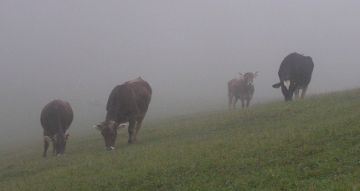Peter Habegger
The Habeggers on the Nieder-Schwarzentrub farm are one of the most respected families in the parish of Trub. The father is respected by the pastor and the parish. His son, however, holds deceptive views. He is summoned to the court, but does not appear.
The bailiff of Trachselwald also intervenes, and now the father acts: he disinherits his son and Peter loses the stately farm. As an Anabaptist teacher, he plays an important role in inner-Anabaptist disputes, which lead to the emergence of the stricter Amish in 1693. Entered, wanted by the authorities, dispossessed - and yet: Peter Habegger does not want to emigrate any more than the Amish.
He visited Anabaptists who had fled to Alsace and the Palatinate. Sobered by their plight, he became a radical opponent of emigration and flight. He urges his brothers and sisters to "stay in the country as long as they can, where they have it nowhere better than here”. However, many of his friends and descendants did not stay - they emigrated to the Jura Franches-Montagnes and to North America.
More information:
The Anabaptist teacher Peter Habegger from Schwarzentrub (1655-?)
The Habeggers on the Nieder-Schwarzentrub farm were one of the respected and wealthy families in the sprawling parish of Trub. Since the 1630s, Peter Habegger and Anna Gerber have lived on the farm with a growing flock of children.[1] Since 1673, his father has held the influential position of a verger and enjoys the trust of the pastor and the congregation. Surprisingly for everyone, however, he resigns just two years later.[2] Was it perhaps because everything in the family was no longer going so smoothly? Could it be that the youngest son, Peter, was already making his growing Anabaptist convictions known in the family circle, thus plunging the father into conflicts of loyalty? We do not know.

Staying (almost) invisible - just like cows in the fog.
(Photo: Markus Rediger).
But the Anabaptist convictions of son Peter could not be kept secret for long. Not appearing at church services and communion for years was bound to attract attention. Especially in such a well-known family.
Peter Habegger, now almost 29 years old, is promptly summoned to appear before the court in February 1684, but does not appear there.[3] After the bailiff of Trachselwald is also called in, the father acts immediately. Before further disaster can befall the family, he disinherits his son Peter.[4] As the youngest male descendant, the junior thus loses the farm, estimated at 12,000 pounds, which would have gone to him according to the applicable law.
With luck and thanks to the help of neighbors, Habegger was able to escape imprisonment again and again. As early as the 1690s, he apparently played an important role in the intra-Anabaptist conflicts with a group of Anabaptists from the Oberland around the brothers Jakob and Ulrich Amman from Erlenbach in the Simmental.[5]
He appears repeatedly in the so-called "separation letters," since he is apparently seen by the Amish side as a central contact for the Anabaptist movement in the upper Emmental, which favors a less strict line. Habegger is also among the signatories of a document formulated in Ohnenheim near Colmar in Alsace on March 13, 1694, where a number of Swiss and Palatine community leaders made the break with the Amish.
Peter Habegger had been disinherited by his father and is wanted by the authorities. Nevertheless, he seems to have succeeded in owning cattle by devious means and to let them graze on Truber soil - as it were under the eyes of the authorities. But even this did not escape the authorities in the long run: at the beginning of 1709, 20 cows were confiscated from him by the bailiff of Trachselwald..[6]
After 1711, Habegger's whereabouts are largely unclear. Again and again it is assumed that Habegger stayed temporarily with the Anabaptist teacher Daniel Grimm from Langnau, who had fled to Lucerne.[7]
As an Anabaptist teacher, Peter Habegger had often visited Bernese Anabaptists who had fled to Alsace and the Palatinate. Disillusioned by spiritual need and material misery in these communities, Habegger had become a radical opponent of emigration and flight in his homeland. According to Pastor Stapfer of Trub, it was Habegger who "most diligently suggested to his brethren in faith that they should stay in the country as long as they could, where they had it nowhere better than here in the country".[8] For Habegger, therefore, the repression by his own authorities - which he assessed as merely temporary - seems to have been the lesser evil than the breaking off of all established relationships and the definitive leaving of his homeland. Accordingly, he emphasized with Psalm 24: "The earth is the Lord's - and all that is in it!" Therefore, no earthly authority had the right to expel them from their homeland! Also not the gracious lords of Bern!
However, even he could not prevent several of his Anabaptist relatives and neighbors from settling later in the Princely Bishopric of Basel in the Jura Franches-Montagnes. Several descendants still live there today - but many more now live in North America. [9]
[1] Concerning the marriage of the couple on February 6, 1632, cf. KB Trub 21, 7. Concerning the baptism of their children Elsbeth, Vinzenz, Christina, Ueli, David, Abraham, Hans, Barbara and Peter in the years from 1637 to 1655, cf. the information in StABE, KB Trub 2 and 3.
[2] StABE, CGM Trub 2, 26.
[3] StABE, CGM Trub 2, 197.
[4] StABE, Bez Trachselwald A 490, 68ff.
[5] See Hanspeter Jecker, Die Entstehung der Amischen (1693ff.), in: Mennonitica Helvetica 42 (2019), 64-80.
[6] StABE, Bez Trachselwald A 989, 15.
[7] StABE, B III 122, 553ff.
[8] StABE, B III 122, 553ff.
[9] See Virgil Miller, Both Sides oft he Ocean. Amish-Mennonites from Switzerland to America, Morgantown 2002.



